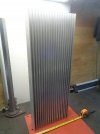No, in the example voltage limitation above (20V), the output voltage is limited due to the amp's current limitation. Power output is a function of voltage, current and resistance:
P = IV = V²/R = I²R
With low impedance ("resistance") loadspeakers, power output is limited by an amp's ability to supply current (V = IR). If current is limited, the amp will clip at a lower output voltage. I've used the terms impedance and resistance interchangeably here for simplicity. In practice, we use Z for impedance rather than R. Z is a combination of resistance R, capacitance C, and inductance, L. A speaker is a complex impedance load (it's "resistance" to current flow is frequency dependent, which also results in frequency dependent phase shifts between voltage and current). That's why impedance is normally shown as a graph against frequency. Both impedance and resistance use the same, unit, the ohm.

